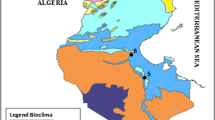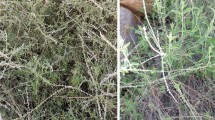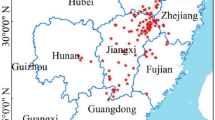Abstract
Capparis spinosa is one of the most important species in the genus Capparis owing to its ecological, medicinal and economic values. It spread in the North of Africa and grows naturally in Morocco. In this work, we evaluate the inter-variation, in eight natural Moroccan populations of Capparis spp. from the Fez-Meknes region in north-central Morocco, at the morphological and genetic level. Genetic variation of this species was assessed using Inter-Simple Sequence Repeats (ISSR) markers. The morphological traits submitted to canonical discriminant analysis enabled separation of eight populations of C. spinosa. The AMOVA results revealed that the genetic variation among the populations (13%) was revealed to be significantly less pronounced than that observed within the some populations (87%). The STRUCTURE analysis and cluster analysis assumed from the Unweighted Pair Group Method with Arithmetic Averages (UPGMA) highlighted three groups within the ISSR data. Our results suggested the presence of hybrid forms of C. spinosa in north-central Morocco. The raised levels of genetic variation revealed within the Moroccan Capparis population by ISSR markers indicate that an appropriate conservation program will allow capturing the majority of genetic diversity found within this species to help ensure its long-term breeding success.





Similar content being viewed by others
References
Allaith AAA (2016) Assessment of the antioxidant properties of the caper fruit (Capparis spinosa L.) from Bahrain. J Assoc Arab Univ Basic Appl Sci 19:1–7
Andrade G, Esteban E, Velasco L, Lorite MJ, Bedmar EJ (1997) Isolation and identification of N2-fixing microorganisms from the rhizosphere of Capparis spinosa (L.). Plant Soil 197:19–23. https://doi.org/10.1023/A:1004211909641
Chakhchar A, Haworth M, El Modafar C, Lauteri M, Mattioni C, Wahbi S, Centritto M (2017) An assessment of genetic diversity and drought tolerance in argan Tree (Argania spinosa) populations: potential for the development of improved drought tolerance. Front Plant Sci 8:276
Chedraoui S, Abi-Rizk A, El-Beyrouthy M, Chalak L, Ouaini N, Rajjou L (2017) Capparis spinosa L. in a systematic review: a Xerophilous species of multi values and promising potentialities for agrosystems under the threat of global warming. Front Plant Sci 8:1845
Doyle JJ, Doyle JL (1990) Isolation of plant DNA from fresh tissue. Focus 12:3–15
Eddouks M, Lemhadri A, Michel JB (2005) Hypolipidemic activity of aqueous extract of Capparis spinosa L. in normal and diabetic rats. J Ethnopharmacol 98:345–350
Eddouks M, Lemhadri A, Hebi M, Hidani AE, Zeggwagh NA, Bouhali BE, Hajji L, Burcelin R (2017) Capparis spinosa L. aqueous extract evokes antidiabetic effect in streptozotocin-induced diabetic mice. Avicenna J Phytomed 7:191–198
El Amri N, Errachidi F, Bour A, Chabir R (2019b) Characterization of Moroccan raw and processed caper berries. Mater Today Proc 13:841–849
Amri NE, Errachidi F, Bour A, Bouhaddaoui S, Chabir R (2019a) Morphological and nutritional properties of Moroccan Capparis spinosa seeds. Sci World J. https://doi.org/10.1155/2019/8594820
Fici S (2001) Intraspecific variation and evolutionary trends in Capparis spinosa L. (Capparaceae). Plant Syst Evol 228:123–141
Fici S (2014) A taxonomic revision of the Capparis spinosa group (Capparaceae) from the Mediterranean to Central Asia. Phytotaxa 174:1–24
Fici S (2015) A taxonomic revision of the Capparis spinosa group (Capparaceae) from eastern Africa to Oceania. Phytotaxa 203:24–36. https://doi.org/10.11646/phytotaxa.203.1.2
Fu XP, Wu T, Abdurahim M, Su Z, Hou LX, Aisa HA, Wu H (2008) New spermidine alkaloids from Capparis spinosa roots. Phytochem Lett 1:59–62. https://doi.org/10.1016/j.phytol.2008.01.001
Gan L, Zhang C, Yin Y, Lin Z, Huang Y, Xiang JY, Fu C, Li M (2013) Anatomical adaptations of the xerophilous medicinal plant, Capparis spinosa, to drought conditions. Hortic Environ Biotechnol 54:156–161. https://doi.org/10.1007/s13580-013-0162-3
Gristina AS, Fici S, Siragusa M, Fontana I, Garfi G, Carimi F (2014) Hybridization in Capparis spinosa L.: molecular and morphological evidence from a Mediterranean island complex. Flora 209:733–741. https://doi.org/10.1016/j.flora.2014.09.002
Harborne JB, Williams CA (2000) Advances in flavonoid research since 1992. Phytochemistry 55:481–504
Higton RN, Akeroryd JR (1991) Variation in Capparis spinosa L. in Europe. Newton, flora Europea: notulea systematicae and floram europeam tantes. Series 2,4. Bot J Linn Soc 106:104–112
Inocencio C, Alcaraz F, Calderon F, Obon C, Rivera D (2002) The use of floral characters in Capparis sect. Capparis’ to determine the botanical and geographical origin of capers. Eur Food Res Technol 214:335–339. https://doi.org/10.1007/s00217-001-0465-y
Inocencio C, Rivera D, Obón C, Alcaraz F, Barreña J (2006) A systematic revision of Capparis section Capparis (Capparaceae). Ann Missouri Bot Gard 93:122–149
Kala PC, Mathur BV (2002) Patterns of plant species distribution in the Trans-Himalayan region of Ladakh, India. J Veg Sci 13:751–754. https://doi.org/10.1111/j.1654-1103.2002.tb02104.x
Keylock CJ (2005) Simpson diversity and the Shannon-Wiener index as special cases of a generalized entropy. Oikos 109:203–207
Khanfar MA, Sabri SS, Zarga MH, Zeller KP (2003) The chemical constituents of Capparis spinosa of jordanian origin. Nat Prod Res 17:9–14. https://doi.org/10.1080/10575630290034302
Kulisic-Bilusic T, Balzevic I, Dejanovic B, Milos M, Pifat G (2010) Evaluation of the antioxidant activity of essential oils from caper (Capparis spinosa) and sea fennel (Crithmum maritimum) by different methods. J Food Biochem 34:286–302. https://doi.org/10.1111/j.1745-4514.2009.00330.x
Lam SK, Ng TB (2009) A protein with antiproliferative, antifungal and HIV-1 reverse transcriptase inhibitory activities from caper (Capparis spinosa) seeds. J Phytomed 16:444–450. https://doi.org/10.1016/j.phymed.2008.09.006
Mousavi SH, Hosseini A, Bakhtiari E, Rakhshandeh H (2015) Capparis spinosa reduces Doxorubicin-induced cardio-toxicity in cardiomyoblast cells. Avicenna J Phytomed 6:489–494
Muhaidat R, Al-Qudah AM, Al-Shayeb A, Jacob HJ, Al-Jaber H, Hussein E et al (2013) Chemical profile and antibacterial activity of crude fractions and essential oils of Capparis ovata Desf. and Capparis spinosa L. (Capparaceae). Int J Integr Biol 14:39–47
Nei M (1978) Estimation of average heterozygosity and genetic distance from a small number of individuals. Genetics 89:583–590
Nosrati H, Hosseinpour Feizi MA, Mazinani M, Haghighi AR (2012) Effect of population size on genetic variation levels in Capparis spinosa (Capparaceae) detected by RAPDs. Eur Asian J BioSci 6:70–75
Ozcan M, Hacıseferogullari H, Demir F (2004) Some physico-mechanic and chemical properties of capers (Capparis ovata Desf. var. canescens (Coss.) Heywood) flower buds. J Food Eng 65:151–155
Rhimi A, Mnasri S, Ben Ayed R, Bel Hajj Ali I, Hjaoujia S, Boussaid M (2019) Genetic relationships among subspecies of Capparis spinosa L. from Tunisia by using ISSR markers. Mol Biol Rep 46:2209–2219. https://doi.org/10.1007/s11033-019-04676-z
Rhizopoulou S, Ioannidi E, Alexandredes N, Argiropoulos A (2006) A study on functional and structural traits of the nocturnal flowers of Capparis spinosa L. J Arid Environ 66:635–647
Rivera D, Inocencio C, Obon C, Alcaraz F (2003) Review of food and medicinal uses of Capparis L. subgenus Capparis (Capparidaceae). Econ Bot 57:515–534
Rodrigo M, Lazaro MJ, Alvarruiz A, Giner V (1992) Composition of capers (Capparis spinosa): influence of cultivar, size and harvest date. J Food Sci 57:1152–1154
Saadaoui E, Guetat A, Tlili N, El Gazzah M, Khaldi A (2011) Subspecific variability of Tunisian wild populations of Capparis spinosa L. J Med Plants Res 5:4339–4348
Saifi N, Ibijbijen J, Echchghadda G (2011) Genetic diversity of Caper plant (Capparis sp.) from Morocco. J Food Agric Environ 9:299–304
Sharaf M, El-Ansari MA, Saleh NAM (2000) Quercetin triglycoside from Capparis spinosa. Fitoterapia 71:46–49
Sher H, Alyemeni M (2010) Ethnobotanical and pharmaceutical evaluation of Capparis spinosa L, validity of local folk and Unani system of medicine. J Med Plants Res 4:1751–1756
Sozzi GO (2001) Caperbush: botany and horticulture. Hortic Rev 27:125–188
Zhang H, Ma ZF (2018) Phytochemical and pharmacological properties of Capparis spinosa as a medicinal plant. Nutrients 10:116. https://doi.org/10.3390/nu10020116
Zuo W, Ma M, Ma Z, Gao R, Guo Y, Jiang W et al (2012) Study of photosynthetic physiological characteristics of desert plant Capparis spinosa L. J Shihezi Univ 3:006
Acknowledgements
All authors acknowledge Dr. Jamal CHARAFI, from INRA-CRRA, Meknès, Maroc, for his help in laboratory analysis.
Author information
Authors and Affiliations
Corresponding author
Ethics declarations
Conflict of interest
No potential conflict of interest was reported by the authors.
Additional information
Communicated by M. Prasad.
Publisher's Note
Springer Nature remains neutral with regard to jurisdictional claims in published maps and institutional affiliations.
Rights and permissions
About this article
Cite this article
Bourhim, T., Chakhchar, A., Lamaoui, M. et al. Morphological characterization and assessment of genetic diversity of natural Moroccan populations of Capparis spinosa. Acta Physiol Plant 43, 37 (2021). https://doi.org/10.1007/s11738-021-03209-1
Received:
Revised:
Accepted:
Published:
DOI: https://doi.org/10.1007/s11738-021-03209-1




